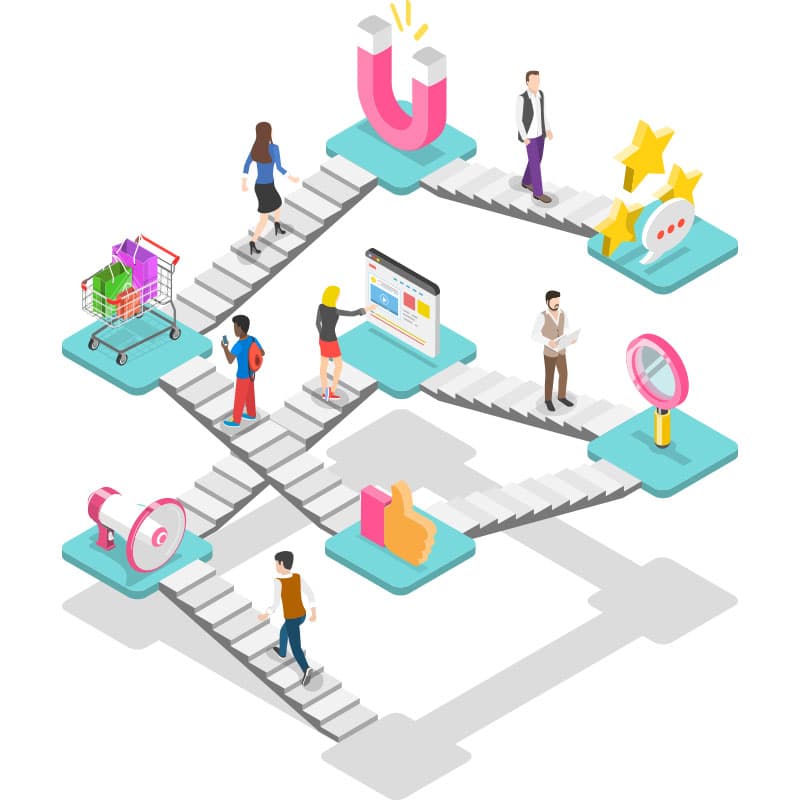Customer Journey: How to offer the perfect online-shopping experience
The customer journey is a very common marketing tool for understanding, influencing and guiding customers throughout the purchasing process. A good product or service provides a positive user experience. And happy users become customers easily.
From the first contact with the product up to the after-sales experience, the ideal customer comes full circle to a satisfying experience. Thus, he or she is likely to buy again or to share the experience with other potential customers.
But what are the different stages of a customer journey and which touchpoints need the most attention? In this article we offer answers to these questions and many more regarding the customer journey.
Definition of Customer Journey
The marketing-related term “customer journey” describes the number of touchpoints a customer has with a brand, a product or a service on his or her path to purchasing something. It describes the whole decision-making process involved in purchasing an item – from hearing about it the first time to actually buying it. This allows businesses to analyze and evaluate the relationship with its customers at every stage of their shopping experience. This strategy provides the opportunity to improve the customer experience and shows potential ways to win new customers.
Everything is based on touchpoints
Customer journey analysis is used as a marketing tool for B2B as well as B2C business models. There are quite a lot of different customer journey models one can use. But there is one thing they all have in common: Touchpoints. Customers don’t usually purchase a product when they first hear about it – they need time to decide and proceed through different touchpoints. In order to get a complete overview of a customer journey, these touchpoints can be tracked and evaluated.
There are different types of touchpoints: some can be influenced directly by a business and some influence a potential customer from the outside.

Examples of touchpoints that can be influenced by a business:
- website
- social media
- newsletter
- customer service
- shop window
- every form of advertisement
Examples of touchpoints that cannot be controlled by a business
- word of mouth
- product reviews
- press releases
- product tests
But how exactly can we connect the dots and get a grip on our customers’ path to purchase? Let’s look into a couple of different options!
The AIDA model
The AIDA model is possibly the best-known interpretation of a customer journey. It describes different phases customers go through on their path to purchasing an item. Although this model dates back to the late 19th century, it is still one of the most known and used marketing tools today. The information derived from the AIDA model can be very detailed and therefore helpful in developing long-lasting customer relationships. It consists of four stages:
- Attention
The offered product or service must attract the customers attention. This can happen via different advertising approaches such as newsletter-marketing, social media campaigns or a nicely decorated shop window. Once you have attracted the consumers’ attention, they will most likely take a closer look at your product.
-
Interest
Once the consumers’ attention has been captured, you can get into the details of your product or service. A product description or video provides the perfect opportunity to let your customers know as much as possible about your product and increase their interest. -
Decision
Now is the time to really convince your customers. Point out the many advantages of your product in order to encourage them to place it into their shopping carts. An excellent marketing strategy supports the customer´s wish to purchase your product or to select your service. -
Action
Finally, your customer takes action and purchases your product. You have successfully completed a sales process
But now is not the time to lean back and enjoy your success. Now is your chance to turn a happy customer into a returning customer. The AIDA model simply points out the purchasing decision process, but does not guarantee a happy and hence returning customer. Now it is your turn to ensure your customer is satisfied with your product and to provide an excellent customer service. For example: when customers purchase an item in your online shop you can send them a follow-up e-mail a few days later and give them the opportunity to rate their shopping experience.
Consumer Decision Journey: The new customer journey
Since consumers are constantly moving out of the classic marketing funnel by changing their search query or changing the way to research a product, the classic customer journey model often does not apply. The classic funnel concept does not include all possible touchpoints and key buying factors, meaning that a different, more sophisticated approach to evaluating the customer journey must be taken: the customer decision journey. This approach is less linear than the funnel, but much more realistic. It shows how complicated the purchasing process can be and also takes consumer driven activities as well as recurring purchasing decisions into account. Therefore, this approach is pointed directly at the customer lifetime value.
Phases of the customer decision journey
- Trigger
The customer has a problem they are trying to solve. This can be the need of a certain product or service. They start their research with the initial consideration set – a set of brands they already know. - Active Evaluation
The consumer evaluates different possibilities and brands in approach to solve the problem. Finally, they decide on a specific product or brand. - Moment of Purchase
The consumer makes the decision to buy a certain product and completes the purchase. - Post-purchase Experience
Based on the customer experience with the purchase, he or she might consider buying the item again or returning to the shop. If everything goes well and the customer is satisfied, the evaluation process may no longer be necessary the next time they are in need of something and they will buy the product directly.
The Moments of Truth model
The technological progress of the information society makes it easy for potential customers to switch between different channels to gather information. This has led businesses to lose their informational advantage. In reaction to this development, a new customer journey model is needed that takes into account the customer´s perspective and considers the differing situations which members of the target group might be in at a certain moment.
Phases of the Moments of Truth model
- First Moment of Truth
The customer decides for or against a product that is directly in front of them - Second Moment of Truth
The customer uses the product or a service and evaluates whether their expectations have been met. - Third Moment of Truth
The customer shares their experience with the seller or a third party. - Zero Moment of Truth
The customer searches the internet for information on a specific product or service. This moment of truth also includes services and products that take longer to decide on, therefore the customer needs more detailed information to support his decision. We also refer to this as micro moments. - Ultimate Moment of Truth
Users of a certain product share their experience via social media. This creates the opportunity to turn one customer´s UMOT into another customer´s ZMOT if they are looking exactly for the provided information.
Customer Journey Mapping: data basis
Tracking and CRM-Systems make it possible to gather and assign contacts collected digitally or otherwise. With these collected data a model is designed that can take the actual and future customer journey into consideration. Buyer personas, the ideal customers, must therefore be defined, as well as their individual motivations for certain actions.
Based on these gathered and purchased data a possible purchasing process for the individual buyer personas can be defined and the touchpoints of the target group with the product or service can be derived. Web analytics or CRM tools are generally used as a data basis. This base allows the separate points of the customer journey to be evaluated with regards to the defined business goals.
Visualizing the customer journey
To visualize the customer journey, we recommend using a tabular form. In the process the following questions should be answered for every touchpoint / phase and persona:
Actions:
- What does the user do at this particular moment?
- How can I take the user to the next step of the customer journey?
Questions:
- Do I offer answers to all possible questions the customer may have regarding my product or service?
Obstacles:
- What might keep the user from taking the next step?
Creating the best customer experience with envivo.io
With envivo.io as your partner you can turn all these lessons into actions.
By using the envivo.io tool, you can see every step of your customer´s journey during the purchasing process, stay in touch with your users and adapt the different steps accordingly.
If you are trying to find out what might keep users from taking the next step in their customer journey, the answer can be derived from the clean layout of an envivo.io report. Adjust your report exactly to your needs and let it show you the numbers you need in order to create the best customer experience possible.
Get in touch with your customers at different touchpoints and escort them through their customer journey using the chat option. You will receive a noticeably higher number of customer requests than via phone or email. This enables you to answer your customers´ questions yourself and prevent them from wandering to different sources to gather information for their research.
The possibilities of envivo.io are endless – start your free 14-day trial now and discover the different features yourself. envivo.io can, of course, be personalized individually to your needs.
















